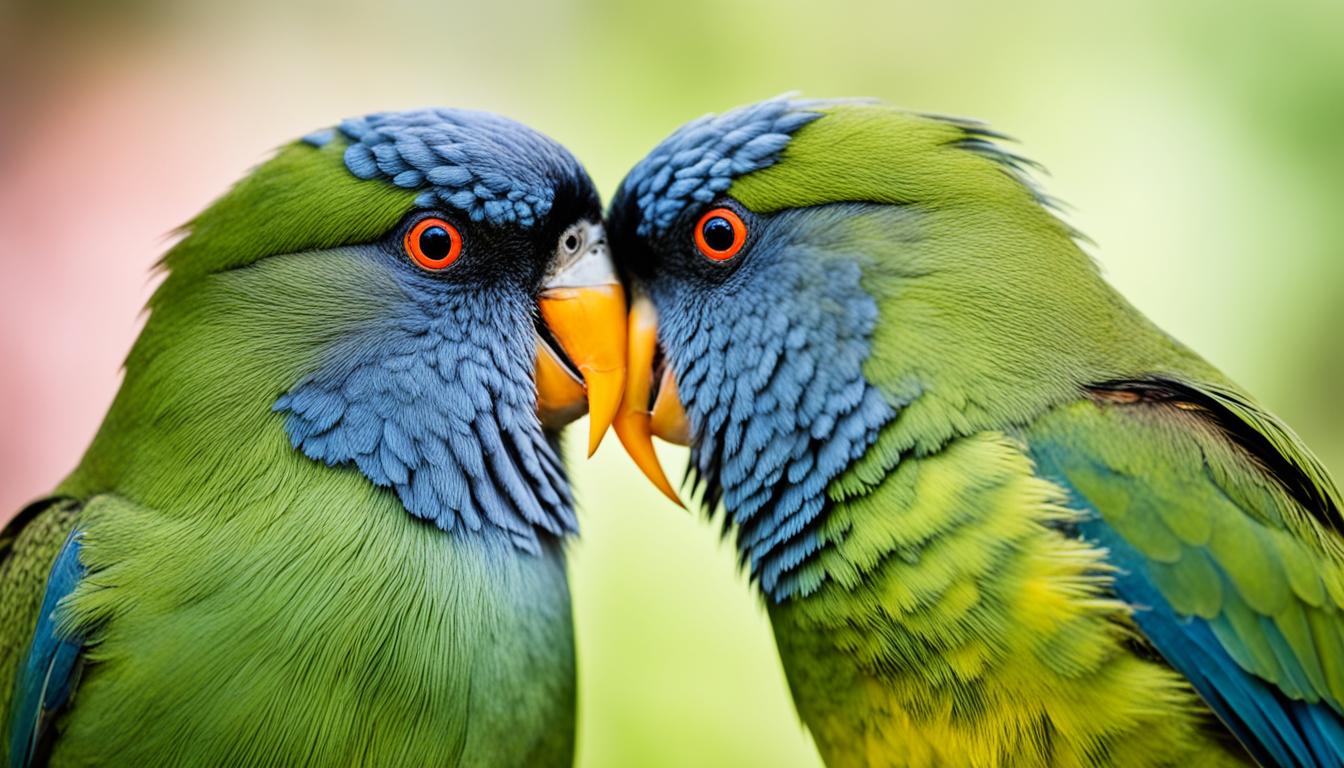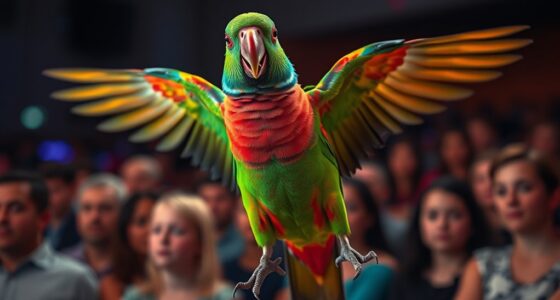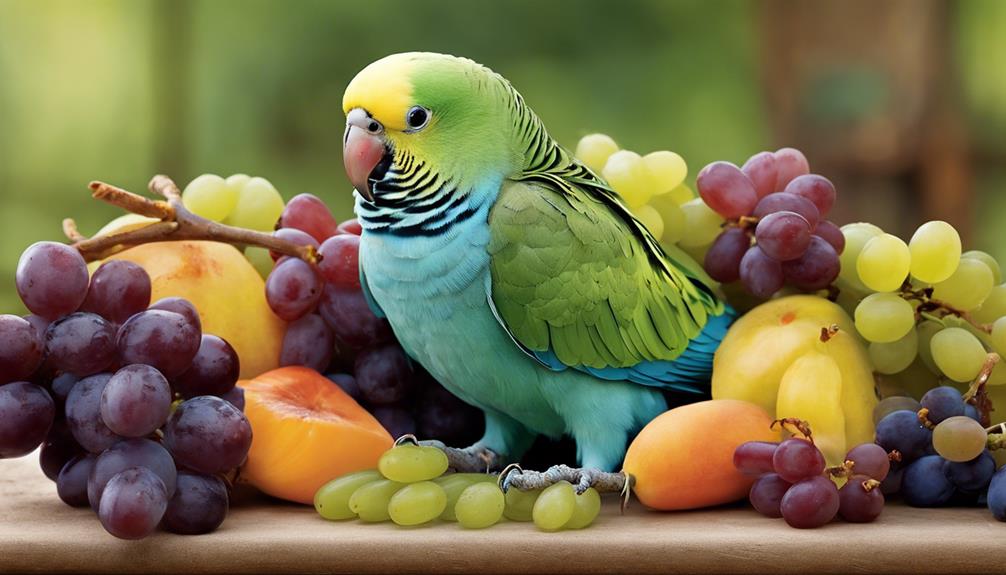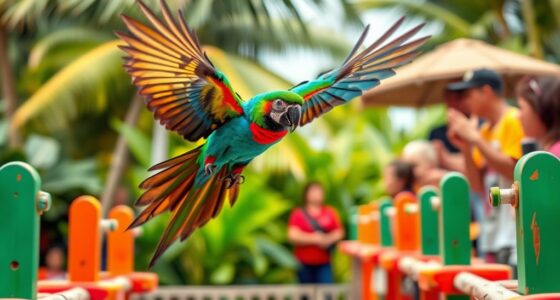Did you realize that birds can display affection towards their human companions? It’s a fact! These feathered creatures, with their distinctive behaviors and communication methods, have an intriguing way of expressing their love and building social bonds.
In this article, we will delve into the captivating world of bird behavior and communication, exploring the dynamics of affection between birds and humans. By understanding how birds show affection, we can gain deeper insights into their emotions and social connections, forging a stronger bond with these remarkable creatures.
Key Takeaways:
- Birds have the capacity to show affection towards their human companions.
- Understanding bird behavior and communication can help establish a stronger bond.
- Exploring avian affection dynamics provides insights into their emotions and social connections.
- Forming a deep connection with birds enhances the companionship between humans and birds.
- Stay tuned to unravel the fascinating world of bird behavior and affectionate interactions!
The Language of Feathers: Conveying Emotions and Intentions
Feathers are not just beautiful accessories adorning birds; they are powerful tools of communication. In the intricate world of avian behavior and bird language, feathers play an essential role in conveying emotions and intentions. Understanding the language of feathers is key to deepening our connection with our feathered friends and deciphering the messages they wish to convey.
When birds engage in tender preening, meticulously grooming each feather, it signifies not only self-care but also strengthening social bonds. By meticulously tending to their plumage, birds build trust and intimacy with their flock and potential mates. The delicate act of preening sends a clear message of love, affection, and companionship.

Flight, a majestic display of freedom and grace, holds even more significance in the avian realm. Synchronized flights and intricate aerial maneuvers can be a mesmerizing dance of communication, conveying complex messages without a need for words. Just like a ballet performance, birds soaring through the air showcase their skill, agility, and unity, while also signaling their emotions and intentions.
As Jane Goodall once said, “The least I can do is speak out for those who cannot speak for themselves.”
In addition to preening and flight patterns, feathers can also signal a bird’s emotional state and intentions through their positioning. For example, a relaxed bird will have its feathers set smoothly, while an agitated or threatened bird might ruffle its plumage, making itself appear larger and more menacing. These visual cues help us better understand our avian companions’ feelings and respond accordingly to foster a positive and nurturing environment.
The Secret Language of Feather Coloration
Feathery wonders extend beyond their physical presence. The coloration of feathers can hold significant meaning in the bird world, adding depth and nuance to their communication. Vibrant and bold colors often symbolize strength, vitality, and vitality, while muted and subtle hues can indicate a more subdued or cautious message.
A notable example of color symbolism in birds is found in male peafowls, or peacocks, whose resplendent iridescent feathers are a display of their genetic fitness and ability to attract mates. The striking plumage of these magnificent birds serves as a visual representation of courtship and seduction, captivating potential partners and asserting dominance among rivals.
Similarly, some bird species employ coloration to blend seamlessly with their surroundings, ensuring their survival by evading predators, or to camouflage themselves during hunting. These clever adaptations highlight the strategic use of feathers in bird communication and the diverse ways in which they serve practical functions in the natural world.
Feathers and Human Connection
As humans, we can learn a great deal from avian communication. By observing and understanding the language of feathers, we can build deeper connections with our feathered companions and enhance our ability to communicate with them effectively.
Next time you interact with a bird, pay attention to their feathers and the messages they convey. Take note of their condition, patterns, and colors. This conscious awareness allows us to respond appropriately, providing comfort, reassurance, or simply enjoying the unique beauty of their plumage.
Whether you are a bird lover, a researcher, or someone interested in the complexities of animal behavior, exploring the language of feathers is a fascinating journey worth embarking on. It reminds us that there is a hidden world of communication happening all around us, waiting to be discovered and appreciated.
| Feather Color | Meaning |
|---|---|
| Vibrant and bold colors | Symbolize strength, vitality, and vigor |
| Muted and subtle hues | Indicate a more subdued or cautious message |
| Iridescent feathers (e.g., peacock) | Represent courtship, seduction, and dominance |
| Camouflage and blending colors | Aid in survival, evading predators, or hunting |
Understanding Bird Behavior: Insights into Avian Interactions
To truly understand birds, we need to grasp the intricacies of their behavior. Birds engage in a wide range of activities that provide us with valuable insights into their emotions and social dynamics. From courtship rituals to territorial displays, every action tells a story. Let’s dive into the fascinating world of bird behavior and explore some common behaviors that birds exhibit.
Courtship Rituals: Love is in the Air
Courtship rituals are an integral part of bird behavior, showcasing their affection and readiness to mate. Different bird species have unique courtship displays that involve impressive dances, intricate songs, and colorful plumage. These rituals not only attract potential partners but also allow birds to assess each other’s fitness and compatibility. Witnessing these courtship displays is a testament to the beauty and complexity of avian interactions.
Feather Preening: Bonds Through Grooming
Feather preening is not just a simple act of grooming; it serves as a bonding experience between birds. This behavior involves birds meticulously grooming each other’s feathers, reinforcing social connections and strengthening relationships. Preening also helps in maintaining feather health and integrity, offering valuable insights into the cooperative nature of bird interactions.
Head Bobbing, Wing Flapping, and Vocalizations: Communication in Action
Birds communicate through a range of nonverbal signals and vocalizations. Head bobbing, wing flapping, and various vocal expressions are vital components of bird communication. These behaviors convey messages related to territory defense, vocal recognition, and emotional states. Understanding the nuances of bird communication allows us to decode their interactions and gain a deeper appreciation for their intricate social lives.
Common Bird Behaviors
| Behavior | Description |
|---|---|
| Feather Preening | Birds groom each other’s feathers, reinforcing social bonds. |
| Head Bobbing | Rapid up and down movement of the head, signaling territorial boundaries or courtship interest. |
| Wing Flapping | Intense wing movements often accompanied by vocalizations, used for communication and attracting mates. |
| Vocalizations | Range of calls, songs, and chirps used for various purposes, including territorial defense, courtship, and social bonding. |
By observing and studying these behaviors, we can unravel the intricate world of avian interactions. Through courtship rituals, feather preening, head bobbing, wing flapping, and vocalizations, we gain valuable insights into their emotions, social dynamics, and communication methods. These behaviors contribute to the richness and complexity of the bond between birds and humans. Let’s continue our exploration of bird behavior and discover the psychological impact of bird-human interactions.

The Psychology of Bird-Human Interaction: Mutual Benefits and Emotional Intelligence
Owning a pet bird goes beyond the surface level of companionship; it has been proven to have a profound psychological impact on humans. The bond between birds and humans has the power to reduce stress, alleviate loneliness, and contribute to overall well-being.
When we interact with our feathered companions, we are not only providing them with care and affection but also experiencing reciprocal emotional benefits. Birds possess remarkable emotional intelligence, which allows them to sense and respond to human emotions, creating deep and empathetic connections.
Emotional intelligence, the ability to perceive and understand emotions, is not limited to humans alone. Birds, with their innate sensitivity, can pick up on subtle cues and gestures, enabling them to empathize with us and offer consolation during difficult times. This unique aspect of bird-human interaction enhances our understanding of the complex emotional world of birds.
“Birds offer us unconditional love, a steadfast presence, and a deep emotional connection that words fail to capture. Their ability to sense and respond to our emotions demonstrates their remarkable emotional intelligence.”
The Psychological Benefits of Bird Ownership
The psychological impact of owning a pet bird spans various aspects of well-being. Here are some of the key benefits:
- The companionship of birds reduces stress levels and promotes relaxation.
- Interacting with birds can alleviate feelings of loneliness and provide a sense of purpose.
- Birds can act as social facilitators, sparking conversations and creating connections with others.
- Caring for birds can promote a sense of responsibility and boost self-esteem.
- Watching birds engage in their natural behaviors brings joy and a sense of wonder, fostering a positive mindset.
Uncovering the psychological benefits of bird ownership reinforces the value of the human-bird bond and encourages further exploration of bird-human interactions.
Emotional Intelligence in Birds: Sensing and Responding to Human Emotions
Birds possess a level of emotional intelligence that allows them to not only respond to their own emotions but also sense and adapt to the emotional states of their human companions. This unique ability creates a bond based on understanding and empathy.
Whether it’s comforting us when we’re sad or celebrating with us when we’re happy, birds have an innate ability to recognize and respond to our emotions. Their keen observation skills and intuitive understanding enable them to offer solace during challenging times and become a source of joy and comfort in our lives.
Image:
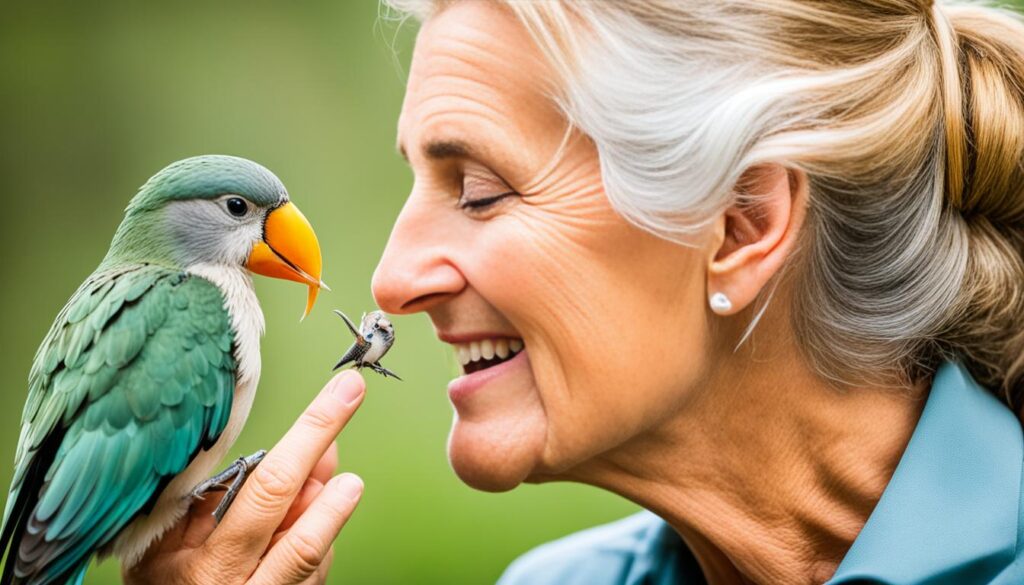
|
The image captures the essence of bird-human interaction, emphasizing the depth of emotional connection between birds and their human companions. The bond formed through such interactions highlights the remarkable emotional intelligence exhibited by birds.
The psychology of bird-human interaction offers a fascinating glimpse into the mutual benefits and emotional intelligence shared between species. As we continue to explore the intricacies of this unique bond, we gain a deeper appreciation for the extraordinary connections that exist between birds and humans.
Birds in Culture: Symbolism and Cultural Practices
Birds have long held symbolic significance in various cultures, representing profound ideas and concepts. They are often associated with love, freedom, and a connection between the earthly and divine realms. Their beauty, grace, and ability to soar high in the sky have captivated human imagination throughout history.
Across different cultures, birds play important roles in literature, art, and mythologies. They are characters in ancient stories and legends, carrying messages and representing spiritual beings. In Native American cultures, for example, the eagle symbolizes strength, courage, and wisdom, while the peacock represents beauty and regality in many Asian cultures.
“Just as birds have captivated our attention and filled our skies, they have also woven themselves into the fabric of our cultural practices and beliefs.”
Understanding the cultural significance of birds deepens our appreciation for the connections between birds and humanity. It allows us to explore the rich tapestry of human history and the diverse ways in which birds have been integrated into our customs, rituals, and folklore. Whether it’s the legendary phoenix rising from its ashes or the swallow symbolizing good luck and loyalty, birds hold timeless symbolism that transcends geographical boundaries.
Bird Symbolism in Different Cultures
To give you a glimpse of the cultural diversity surrounding birds, here are a few examples of bird symbolism in different cultures:
| Culture | Bird Symbolism |
|---|---|
| Egyptian | The ibis, associated with the god Thoth, symbolized wisdom and knowledge. |
| Greek | The owl, representing the goddess Athena, symbolized wisdom, protection, and foresight. |
| Chinese | The crane, believed to be a sacred bird, symbolized longevity and happiness. |
These examples are just the tip of the iceberg, as bird symbolism can be found in countless cultures and continues to shape our understanding of the natural world and its connection to the human experience.
Aside from symbolism, birds also influence cultural practices. In some cultures, bird watching is a popular pastime, bringing people closer to nature and fostering a sense of wonder. Bird-related festivals, such as the Chinese Spring Festival’s dove release, celebrate birds’ role as messengers of peace and new beginnings.
As we explore the cultural significance of birds, we must also acknowledge the challenges and rewards of bird ownership. Owning a bird requires knowledge and commitment to providing optimal care. Here are some expert tips for bird care:
- Ensure a spacious and stimulating environment for your bird with appropriate toys, perches, and cages.
- Provide a balanced diet consisting of high-quality bird food, fresh fruits, and vegetables.
- Establish a consistent routine for feeding, cleaning, and social interaction.
- Consult avian experts for guidance on proper handling and healthcare.
- Make time for daily social interaction and play to keep your bird mentally and emotionally engaged.
By fostering a deeper appreciation for birds’ cultural significance and providing expert care, we can honor the magnificent creatures that have enchanted and inspired us throughout the ages.

Conclusion
The bond between birds and humans is rich and complex, filled with affection, trust, and understanding. Through our exploration of bird behavior, communication, and the psychological impact of bird companionship, we have gained profound insights into the fascinating world of avian emotions. By understanding how birds show affection and appreciating the cultural significance they hold, our admiration for these incredible creatures deepens.
As bird ownership continues to evolve, it is crucial to acknowledge both the challenges and rewards it brings. Providing optimal care for our feathered companions is of utmost importance. Whether it’s creating a stimulating environment, ensuring proper nutrition, or establishing a strong bond through positive reinforcement, we play a vital role in their well-being.
Our connection with birds goes beyond mere ownership. It is a dynamic relationship built on love, respect, and mutual understanding. Birds offer us their companionship, uplifting our spirits and providing solace in times of stress. In return, we have the privilege of witnessing their displays of affection, their unique communication methods, and the profound impact they have on our lives.
